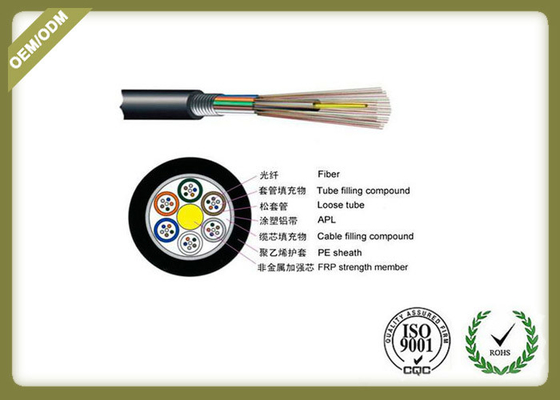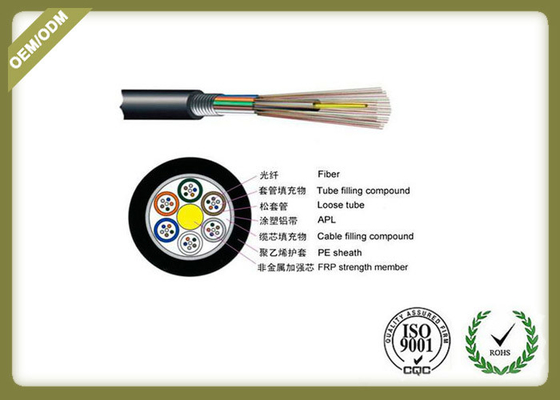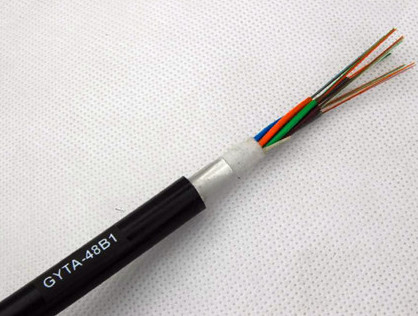|
|
Outdoor Fiber Optic Cable GYTA Aluminum Polyethylene Laminate
Product Details:
Payment & Shipping Terms:
|
| Fiber Type: | Aluminum Armored Cable | Central Strength Member: | Phosphatized Steel Wire |
|---|---|---|---|
| Jacket: | PE | Outer Diameter: | 10.5~18.8+_0.5mm |
| Fiber Count: | 2~288core | Temperature Range: | -40degree +70 Degeree |
| Weight: | 103~302kg | Aplication: | Outdoor Communications,Long Distance And Local Area Network(LAN),Communications. |
| Structure: | APL Moisture Barrier |
Stranded Loose Tube Cable With Aluminum Polyethylene Laminate (LAP) for outdoor use (GYTA)
Description:
The structure of GYTA cable is to insert 250 micron optical fibers into the loose sleeve made of high modulus materials and fill the loose sleeve with waterproof compounds. The core of the cable is a metal reinforced core. For some optical cables with core numbers, a layer of polyethylene (PE) should be extruded outside the metal reinforced core. Loose sleeve (and filling rope) around the center reinforcement core to form a compact and circular cable core, the gap in the cable core is filled with water-blocking filler. Polyethylene sheathed cables were extruded after plastic-coated aluminium strip (APL) was vertically wrapped.
|
Model: GYTA
Fiber type: SM-9/125um-G652D Outer jacket: PE sheath Color of jacket: Black Material : Aluminum Polyethylene Laminate Strength member: Phosphating steel wire Material of filling: Filling Compound |
Important notice:
Many domestic small factories use inferior or waste optical fibers to imitate A-grade optical fibers, non-woven fabrics as water-blocking tapes, waste electric-wires and rubber slippers smashed as raw materials for the outer sheath of cable. Those inferior cables will cause many problems such as short transmission distance, low bandwidth, intermittent signal and easy-to-crack and water seepage of the cable jacket, etc. For the recent years, there are many cases that many overseas customers who bought such inferior cables from China were frustrated to find that the cables can not be used after constructing. It’s not workable to return them to China as the Chinese government will levy high import duties on optical fiber cables. The customers cannot claim for any compensation and suffered huge losses.
Characteristics.
Good mechanical and temperature performance
· High strength looes tube that is hydrolysis resistant
· Special tube filling compound ensure a critical protection of fiber
· Specially designed compact structure is good at preventing loose tubes from shrinking
· PE sheath protects cable from ultraviolet radiation
· The following measures are taken to ensure the cable watertight:
. Steel wire used as the central strength member
. Loose tube filling compound
. 100% cable core filling
. APL moisture barrier
Optical Characteristics:
| Fiber Type | G.652 | G.655 | 50/125^m | 62.5/125^m | |
|
Attenuation (+20X) |
850 nm | <3.0 dB/km | <3.3 dB/km | ||
| 1300 nm | <1.0 dB/km | <1.0 dB/km | |||
| 1310 nm | <0.36 dB/km | <0.40 dB/km | |||
| 1550 nm | <0.22 dB/km | <0.23 dB/km | |||
| Bandwidth | 850 nm | >500 MHz-km | >200 Mhz-km | ||
| 1300 nm | >500 MHz-km | >500 Mhz-km | |||
| Numerical Aperture | 0.200±0.015 NA | 0.275±0.015 NA | |||
| Cable Cut-off Wavelength cc | <1260 nm | <1450 nm | |||
Structure and Technical Specifications
|
Fiber Count |
Nominal Diameter (mm) |
Nominal Weight (kg/km) |
Max FiberPer Tube | Max No. of(Tubes+fillers) |
Allowable Tensile Load (N) |
Allowable Crush Resistance(N/100mm) | ||
| Short Term | Long Term | Short Term | Long Term | |||||
| 2~36 | 10.3 | 109 | 6 | 6 | 1500 | 600 | 1000 | 300 |
| 38~72 | 11.5 | 145 | 12 | 6 | 1500 | 600 | 1000 | 300 |
| 74~96 | 13.5 | 175 | 12 | 8 | 1500 | 600 | 1000 | 300 |
| 98~120 | 14.8 | 209 | 12 | 10 | 1700 | 600 | 1000 | 300 |
| 122~144 | 16.6 | 249 | 12 | 12 | 2000 | 600 | 1000 | 300 |
| 146~216 | 16.7 | 254 | 12 | 18(2 layers) | 2000 | 600 | 1000 | 300 |
| 218~288 | 19.0 | 325 | 12 | 24(2 layers) | 2500 | 600 | 1000 | 300 |
Note : This datasheet can only be a reference, but not a supplement to the contract. Please contact our sales people
for more detailed information.
Standards
GYTA cable complies with Standard YD/T 901-2001as well as IEC 60794-1.
![]()
-
Central loose tube cable,MM OM4,water blocking glass yarn,6.0mm for outdoor/indoor use
-
GYFTY outdoor fiber optical cable with FRP strength member with armid yarn for
-
Loose tube stranding GYFTY outdoor fiber optic cable with FRP with armid yarn
-
CPRI LC to LC FTTA outdoor fiber optic patch cord duplex 7mm diameter for outdoor use
-
Underground Armored Outdoor Direct Buried Fiber Optic Cable GYTA53 reach to 288cores
-
NSN boot LC duplex Fiber Optic Jumper NSN-NSN LSZH 7.0mm diameter





